Recently, we changed our business operations workflow and how we do things internally here at Bottega8.
Ever since we started our company we’ve used Trello in some form or fashion to manage our internal tasks. We used it as a running “to-do” list of things to get done for our business and often had tasks that would be on our to-do list for weeks.
We realized that our Trello workflow wasn’t working for our internal tasks. The cause of Trello not working was not the tool itself but rather the way we were using it and how it was integrated in our workflow. We used Trello for our internal to-do list without any structure which led to tasks not being done on a time. Very quickly we realized that we needed to adjust how we structured our internal tasks.
But Trello Was Working Extremely Well for Our Client Projects
On the other hand, we were wildly successful at using Trello as our project management tool with client projects. We identified that it was the approach and structure of how we were running projects which was reflected in Trello that contributed to its success and not the tool being inefficient.
The way we run client projects is inspired by Thoughtbot. The general structure includes having these columns in Trello: Backlog, Next Up, Doing, “Done for week X”.
Adapting Our Internal Workflow
Since this was working really well for our client projects we thought this structure would work if we took these same principles and used it for our internal Bottega8 trello board.
Here’s how we applied it to the our internal Trello board:
In the above screenshot we have these columns: Backlog, Next Up, and Rishi- doing, Haji-doing, and “done for week X”.
Here’s what each of the columns mean and how we use them:
| Column Name | How We Use This Coloumn |
| Backlog |
Everything that we want to get done goes in this column. These are often items that are not prioritized yet but we want to think about and get to. |
| Next Up |
At the beginning of the week we prioritize what we want to get done that week and pull things from the backlog. This column is designated for work that we can get done or make strides on within a week. We might have to break up items into smaller chunks in order to make sure we can get in done in a week. We error on getting this complete no matter how small it may be. Our thought is if we continue to show progress it will compound on itself and we’ll reach our long-term goals. |
| Doing- Haji |
Cards in this column are things that Haji has on his plate for the coming week. |
| Doing- Rishi |
Cards in this column are things that I have on my plate for the coming week. |
| Done for Week X |
As things get done during the week we move them to the “Done for week X” column. Where X is the date of a particular week. |
Alternatively, you could just have a “Doing” column and have teammates put their face on each of their cards in Trello.
Results from Changing Our Workflow
Thinking about what you need to accomplish on a weekly basis allows us to break down longer term goals into much more actionable tasks. Breaking down these tasks into more concrete and manageable work items, has yielded more tasks getting done on time.
The above workflow doesn’t replace our higher level business goals that we want to achieve. But it does help making sure we are making measurable progress on all our goals, one week at a time.
Hope you found this article useful. We would love to know how you manage tasks at your company in the comments below!



